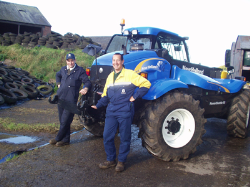
Telehandlers are becoming a more familiar sight on UK farms, able to lift heavier loads with greater precision than a tractor and front loader. However the capabilities of the New Holland's LM415-A do not stop there. By specifying rear linkage and rear pto the versatility of this model is increased further, equipping it to take on a vast range of jobs in the field.
Whether performing as a dedicated front-loader or acting as a second tractor, the LM415-A offers the flexibility to farm as conditions and resources dictate. The rear mounted Cat II three-point linkage has a 2.8 tonne lift capacity complemented by a 1000rpm rear pto, offering plenty of power for applications such as harrowing or bale wrapping.
One farming family to realise the benefit of a rear linkage and pto equipped telehandler are brothers Stewart and Alan Turner. They own and run a mixed farm in Lanark, in the lower Clyde Valley, producing winter rations and silage and providing grazing for sheep. In addition Stewart and Alan offer contracting services, keeping their work schedule busy and varied.
The 95hp LM415-A was purchased with an increasing amount of loader work in mind, but as Stewart explains, it needed to work well in a variety of jobs. "We operate a range of machinery but the telehandler was purchased to replace a Ford 7840 with front loader. We have been running it for six months now and have been very pleased with its abilities.
"The most obvious benefits are the increases in payload capacity, height and reach of the machine. The Ford would lift 1.5 tonnes to three metres, but the telehandler can double both of those figures, which makes loading lorries a straightforward affair. We also benefit from four-wheel steering and PowerShuttle™ transmission, which makes operating in tight areas easy. As with the tractor we have had a boom damper fitted to take out the bounce in the boom, particularly useful when operating with heavy loads or on uneven ground out in the fields.
"For us, fitting the rear linkage and pto was a natural way to get the most out of the machine. We can operate the LM-A very much as a second tractor and use it for light field work, pulling a set of discs or for grass topping. It will not pull a plough, but we never intended it to, but it will easily pull a loaded transport trailer."
The cab on the telehandler sits lower than a tractor cab and to one side, as part of the rear-engined and mid-pivot boom layout of the LM-A Series. "Although it is quite different to the tractor, visibility to the front and high through the cab roof window is good. Visibility to the rear linkage was initially restricted as the operator sits forward of the engine, however with extra mirrors mounted at the rear, reversing up to equipment is easy.
"Apart from position there is little difference; the cab has all the comforts you would find in a modern tractor. We have an air seat, air-conditioning and a radio making it a pleasant place to work."
The LM415-A is part of seven model range of LM-A telehandlers exclusively aimed at, and designed for, farming applications. New Holland has always maintained that the rear-engine configuration is the most appropriate for use in farming situations as it gives optimum weight distribution and direct drive with minimum power losses, as well as contributing to their superior pushing power and climbing ability.
A mid-mounted boom pivot means that heavier loads can be placed further forward, allowing loading and tipping into high-sided trailers with no boom extension – improving work rates and stability.
Power comes from the same engine family as those powering New Holland's new TS-A tractors, again specifically designed for agricultural use. The turbocharged 95hp and turbocharged and intercooled 110hp Tier II engines offer better fuel consumption and up to 42% more torque than their predecessors. Power is converted into handling performance via a four-speed PowerShuttle™ transmission where a large torque converter ensures that high levels of torque are maintained as engine speed drops.
Depending on model, hydraulic control is by way of a mechanical joystick with two levers, a mechanical 'mono' joystick, or an electro-hydraulic proportional flow-sharing joystick. The latter allows more than one function to operate simultaneously and gives fingertip control of the speed of the main function ideal for precision stacking jobs and a 'first' for New Holland telehandlers. In each case, an option to the standard control package is offered, further extending the specification alternatives on what is New Holland's most comprehensive and impressive telehandler range to date.
